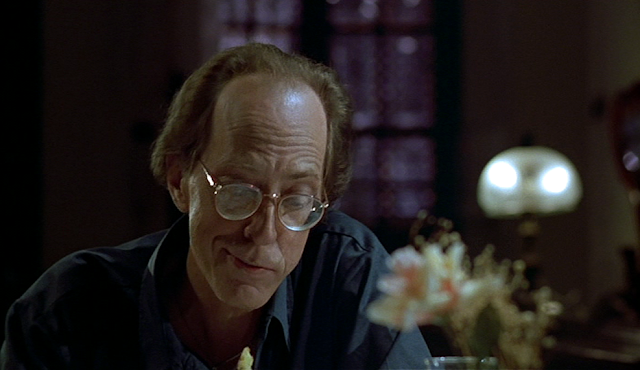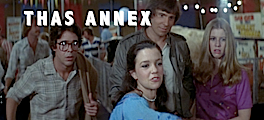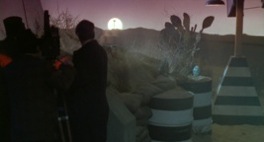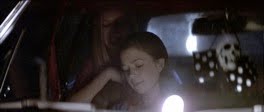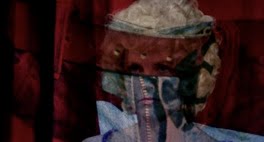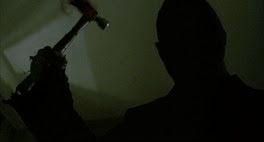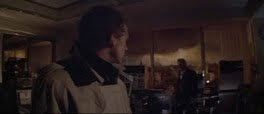"I wanted to show de Sade not as a myth, but as he really was, and I did a lot of research to get a realistic approach to him."
"There are five intertwined stories taking place between our time and de Sade's, mixing dreams and reality. It's a very complex script, but I'm sure people will love it."
Taken from a Fangoria Magazine article circa 1993, these quotes are of Hooper talking about the as-yet-to-be-released Night Terrors (formerly titled Nightmare).
His words, at some level, are a pie in the face. Night Terrors is not "exactly a horror film," but it is definitely oftentimes a silly horror film. Perhaps realistic, it is mostly cornball. If it aims for complexity, it instead is mostly just random, and at inopportune moments also unbearably nonsensical. And people did not love it.
But, those criticisms so self-evident and indefensible, what is defensible is the way Hooper's laundry list of inadequacies and imbecilities still cannot squelch the rich wells of artistic seriousness that characterize him and his films, and the truly meaningful, truly striving cinematic forms and subtextual, humanistic, philosophical designs that are always the end goal in his efforts.
Hooper is hardly an intellectual. This is very much not an erudite, incisive look at the Marquis de Sade, despite Hooper's research efforts. Hooper is a sensitive aesthete, a cinematic poet, a laureate of cinematic grammatical grace, a believer in story - the severity and seriousness of a moral, not commercial, art - and a believer in its divinity (in the philosophical enlightenment of narratives). Night Terrors may offer nothing more than scattered and half-witted commentary on themes of cruelty and religion, sex and sadism, Gnostic moral code and aristocratic abuses, but the motions towards such depth and broad-minded humanist commentary are there, if in its airheaded, barely literate capacity. In being tied up with what is thoroughly bracing, profoundly imbued, uncommonly formalistic cinematic literacy (that "severity and seriousness" of presentation embedded in Hooper's wish to be aesthetic, poetic, grammatical, ascetic, abstractive, lyrical, divine, enlightening, etc.), it makes even a film filled with as much lows as Night Terrors feel generally something to herald and hold up above the rest of the films where entertainment and the fashionable are most often the main purpose. There are indeed alternative criteria for judging art, and Hooper's spirit of Art and altruism - his entire artistic self wedded to a Godliness of the seventh art, in its most pure moral and artistic capacities - pretty much curves the grading scale towards him for me.
It's too bad Night Terrors's worst moments are contained in its third act, killing a lot of good will in its final stretch, because Night Terrors is filled with enough rhetorical distance, social intelligence, and philosophic-minded tonal restraint throughout its running time that it does in fact vaguely approach those mostly underachieved goals mentioned by Hooper in his quotes above: a mature screenplay, more rhetorical pièce érotique than frivolous horror film; an intellectualized narrative of abstractly interweaving timelines, where one such timeline consists mainly of a supposition of the Marquis de Sade - as an aristocrat in prison - made to presentationally recite his prose to us, the audience; a contemplation of the words and reality of de Sade, of the ambivalent status he holds as both a revolutionary mind, and a figure of cruelty and the espousing of cruelty.
But the lows - what lows! The script is often horrendous - sloppy, incomplete, inane or plain nonsensical. Robert Englund - as intelligent, of sharp mind, and possessing of a true actor's gravitas as he seems in real life, and as capable he is at performing broadly and engaging a role at his unique and committed wavelength - is just the hammiest of actors. Production design and make-up is pretty woeful at times. The production in general seems full of limitations, such as when a take is used in which the camera seems to literally unbalance itself on whatever it's mounted to, shaking erratically in the middle of the shot. A rich-people party scene is created with no reasonable idea of what it is supposed to be, apart from the casting of extras based on how weird they look, a rare decision by Hooper I lose respect for him for (then they're apparently failed to be told not to look at the camera). A dream sequence involving a snake woman in a room full of smoke machines is fine in concept (outside of the comically apparent use of smoke machines), but horrendous in execution (why does the gold-painted snake woman wear, then subsequently lose, in an inconceivable lapse of continuity diligence, her pair of gold-painted platform heels?). Any dream sequence, in fact, in this film, is generally a bottom-drawer moment of anti-inspiration. A torture implement that is essentially a heavy-duty, retractable ice pick hardly syncs up with its schlocky sound effect and a parked taxi is given a siren for some reason. I could go on. The final act I mentioned - mainly the scenes taking place inside Englund's villainous character's torture chamber - is quite literally a stream of moronic, non-starting dramatic stakes, driven into the ground in its absolute failure to create performances and motivations that make any sense, or that will join in harmony to create the danger and tension and dramatic propulsion it needs so badly to create. The final act is indeed the cruelest failure of inane and half-witted scripting, Englund's painful (painful...) dramatic limitations, and Hooper's bewildering inability to circumvent any of this, aiding and abetting Englund's groan-worthy theatrics with an utter tin-ear for train-stopping dialogue: for example, Englund's character goes on an exuberant rant about the Christian God's cruelty, which I would usually embrace as clearly evidence of Hooper's humanistic concern (moral diatribes from the Englund-played villain, as moronic as they are, being the vehicle for adding moral dimension in both this and The Mangler), but it is seemingly sabotaged by a colluding Hooper and Englund, deciding to have the character cut himself off in one of those "Whoops, I got carried away!" moments that simply murders the scene dead, drowned in viewers' laughter (Englund fares so much better in The Mangler). A plot development involving Englund's character's desire to obtain an archeological artifact that he somehow predicts is "one of the greatest secrets of Christianity" makes no sense, as it's left simply to that vague fact of being the "greatest secret of Christianity." Its relation to his abduction of Genie and his equally vague plans for her is nonexistent, and Englund's performance in this bit, where he rapturously extols his obtainment of the object, only to be driven into a fury when he is disappointed with what it ultimately is, is quite literally hysterical. I could go on.
Yet. Yet, this is still a picture that embraces and searches for richness in its abstract and associative interweaving narrative: of a main storyline following the moral journey of a young girl - a beguiling, blank slate ingenue - and then unrelated interludes taking place in a bygone era, where a cruel aristocrat's burning prose, fueled while rotting away in a jail cell, represents the philosophical, cultural, and moral clashes this inscrutable girl-sponge is peripherally confronting. It is still a picture about a villain's attempt to corrupt a girl - but the complete failure in doing so. The girl embraces her sexual being, embraces a divergence of lifestyle and culture, and in doing so, is not corrupted but instead shows her largeness of character; shows a strange analytical capacity that functions alongside her persuadable naivete; shows her always triumphantly bypassing and surpassing the prejudices and influences of both a narrow-minded father and the very wide-minded - but amoral - sadists, using what can ultimately be called this ideal ingenue's not-to-be-dismissed, incorruptible, broad mind. This is a picture in which a Christian archeologist is the butt of disdainful objectivity and the high bourgeoisie house's Gnostic domestic worker is the canonized, selfless, heroic savior figure. This is a film that aims to present an apparent tetrarchy of power - the European aristocrat, the modern aristocrat, the ambassadorial power, and the dominant religion (or, as the film puts it, the world of "Eagles") - while alongside them are the respective "Ants" - the poor, the pagan, the Bedouin. The villain is vanquished by Gnostic divine intervention (Hooper's interest in the mystic corners of the world clearly present in the mystically triumphant finale), and the film ends with a completely associative, quite striking and bracing scene in which the dying de Sade, in his cell, is visited by a clergyman and greets the priest's offer of repentance with a spit of diseased blood in the ultimately buffoonish cleric's eye.
I myself often struggle with sustaining the conviction that Night Terrors deserves a level of admiration, so it feels somewhat unsatisfactory leaving this post with but one scene looked at -- when it will take a look at the many more scenes of a striking formal dimension to really bring home the idea of an understated fabric of quality that seeps in along the cracks of Night Terror's surface craptitude, but that will be the case here:
The Domain of the Father
A common Hooper trope is very pronounced establishing shots of buildings, often using them to engender a mood or, most notably, serve as metonymy for the personage - the dignitary behind the edifice, his whole personality and being contained and bolstered up by the structure - which the walls serve to enclose.
Here it is the house of the father: a home of comfort, shelter, success, and Christian ego.
The father's voice:
"Dear Heavenly Father..."
"... thank you for the safe arrival of my daughter, Genie, and for what we are about to receive..."
"In Jesus Christ's name..."
Genie, praying with her eyes open:
"Amen."
"Amen."
"Oh... this is our first meal in six months. This is really special."
A fastidious shot-reverse shot, made of very formalized, medium close-up, "bust" shots.
(Fatima nods toward him.)
"Fatima here - she's something else. A real life saver. Gonna look after us both... take good care of us."
"This is just one of the most exciting times of my life! I mean, it is incredible what's out there. It's like a mini-United Nations, you wouldn't believe it."
"How are they treating you, Daddy?"
"They don't take kindly to Christian archeologists. But, it's sort of what I expected. Anyway, it's gonna be big."
"It's the first..."
"... major Gnostic site anywhere!"
"Gnostics were heretics, right?"
"They were wiped out in the 4th Century A.D. They call themselves Christians, but they have very little to do with Christianity."
"Nothing to do with Christ."
The "bust" shot of Genie being a recurring motif of the film, presenting her as the focal figure and psychology of the film - watching, observing, thinking, absorbing, coming to conclusions of and for her own.
/End of Part 1/
































